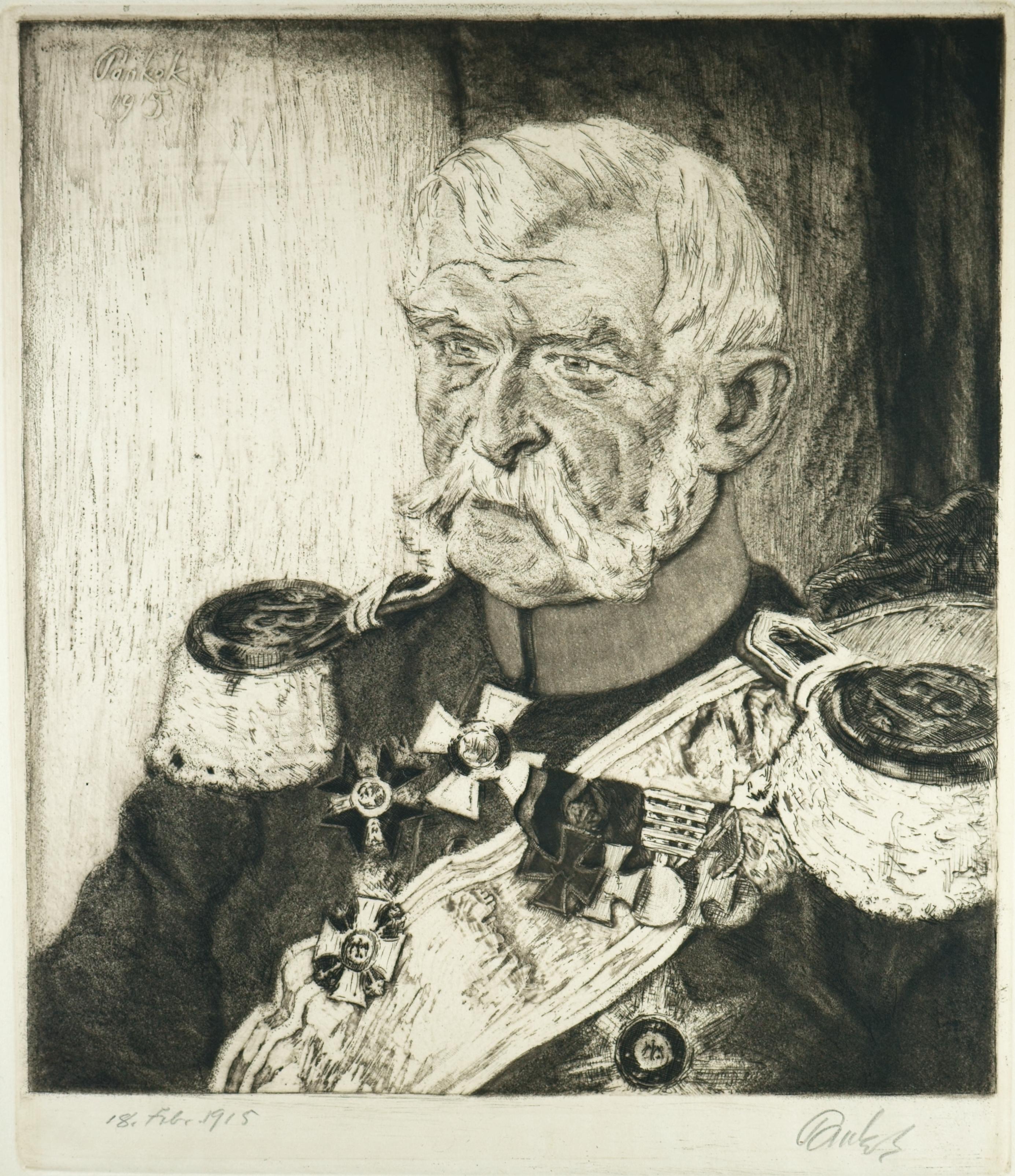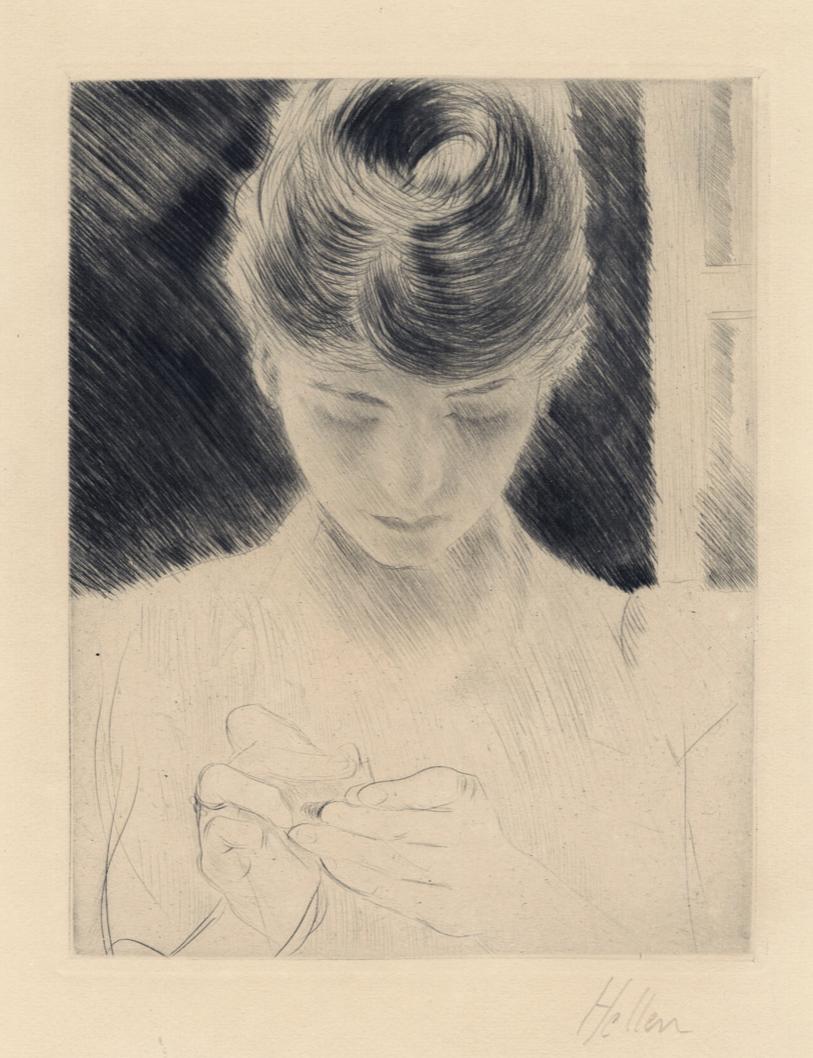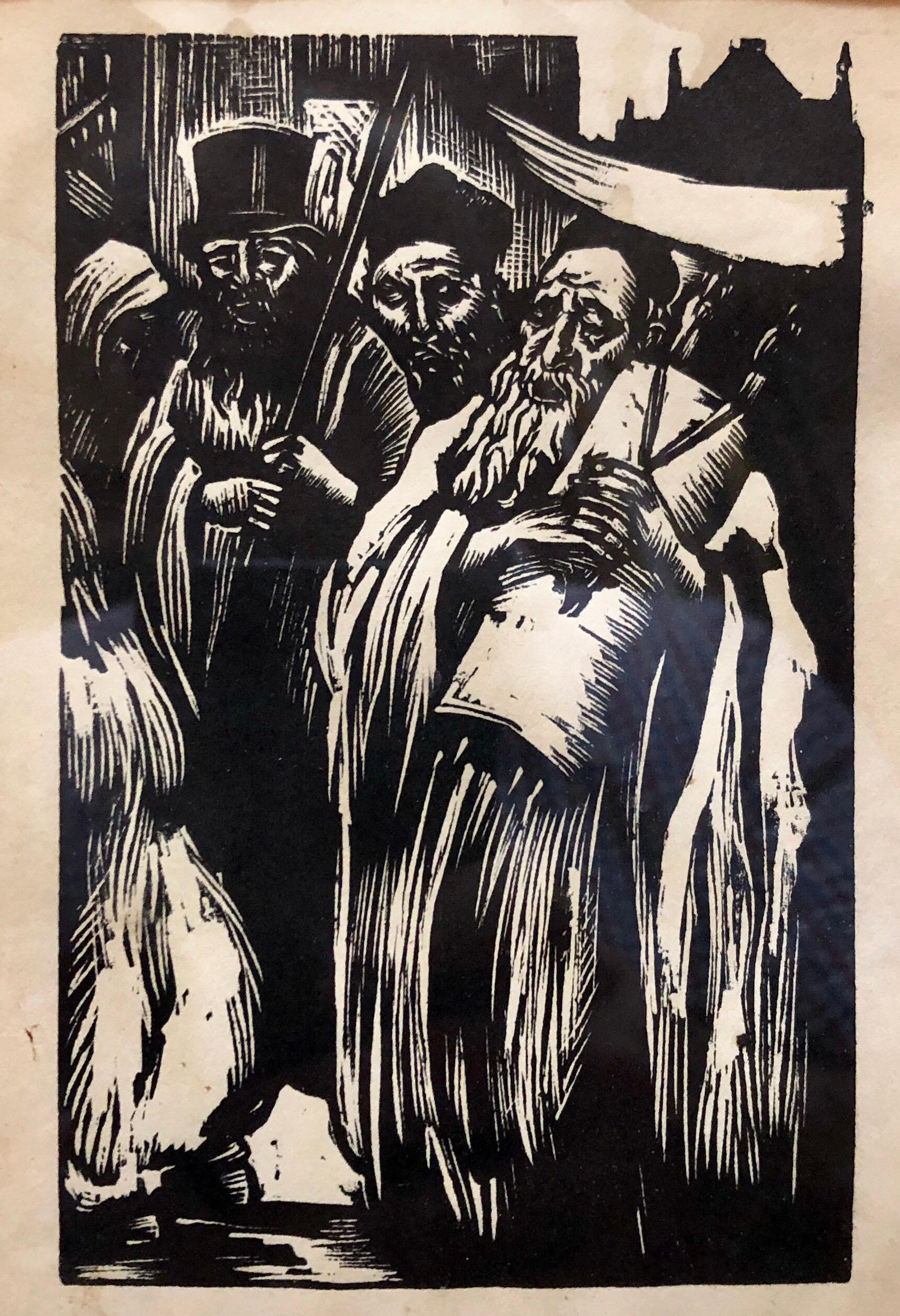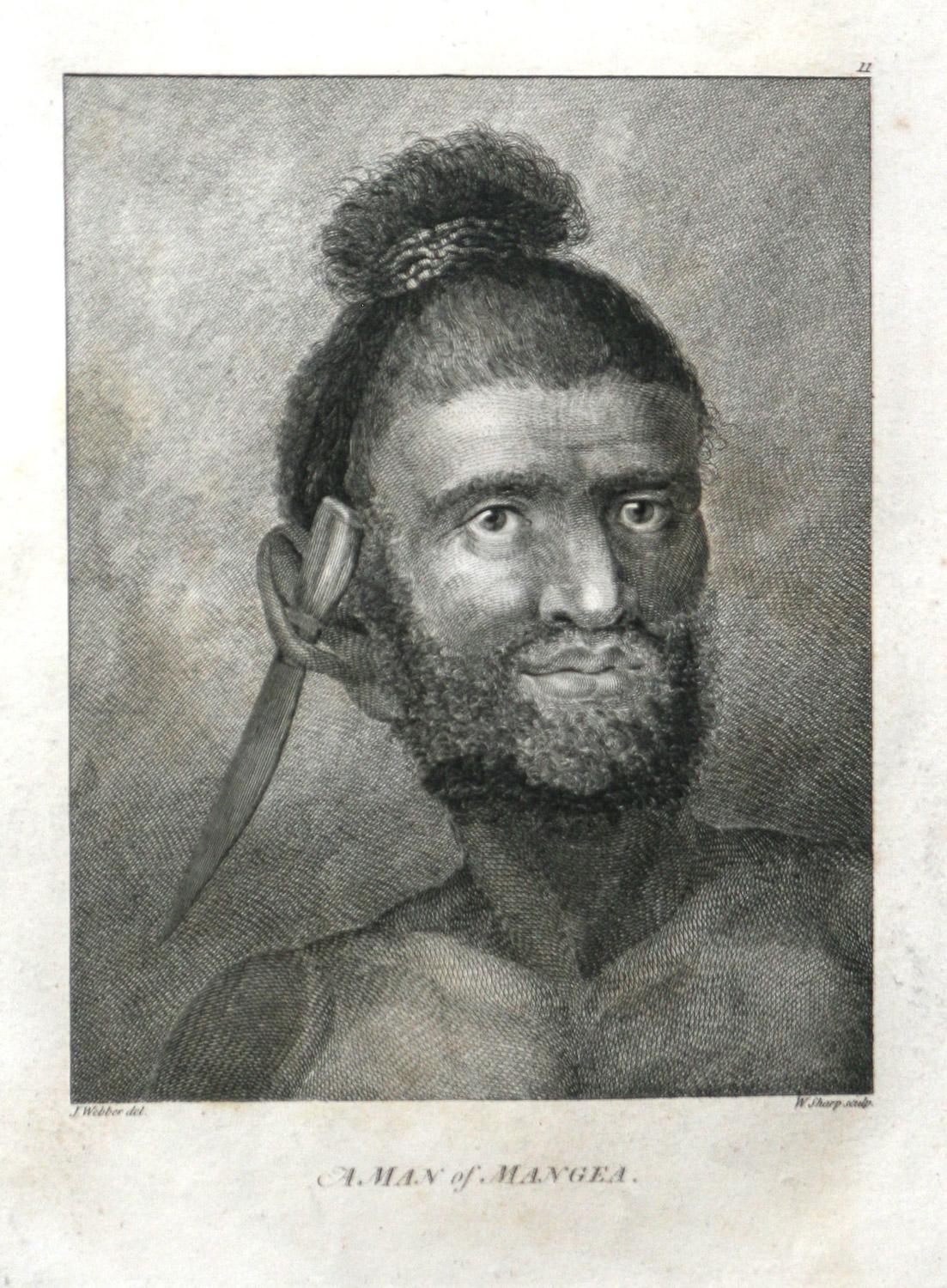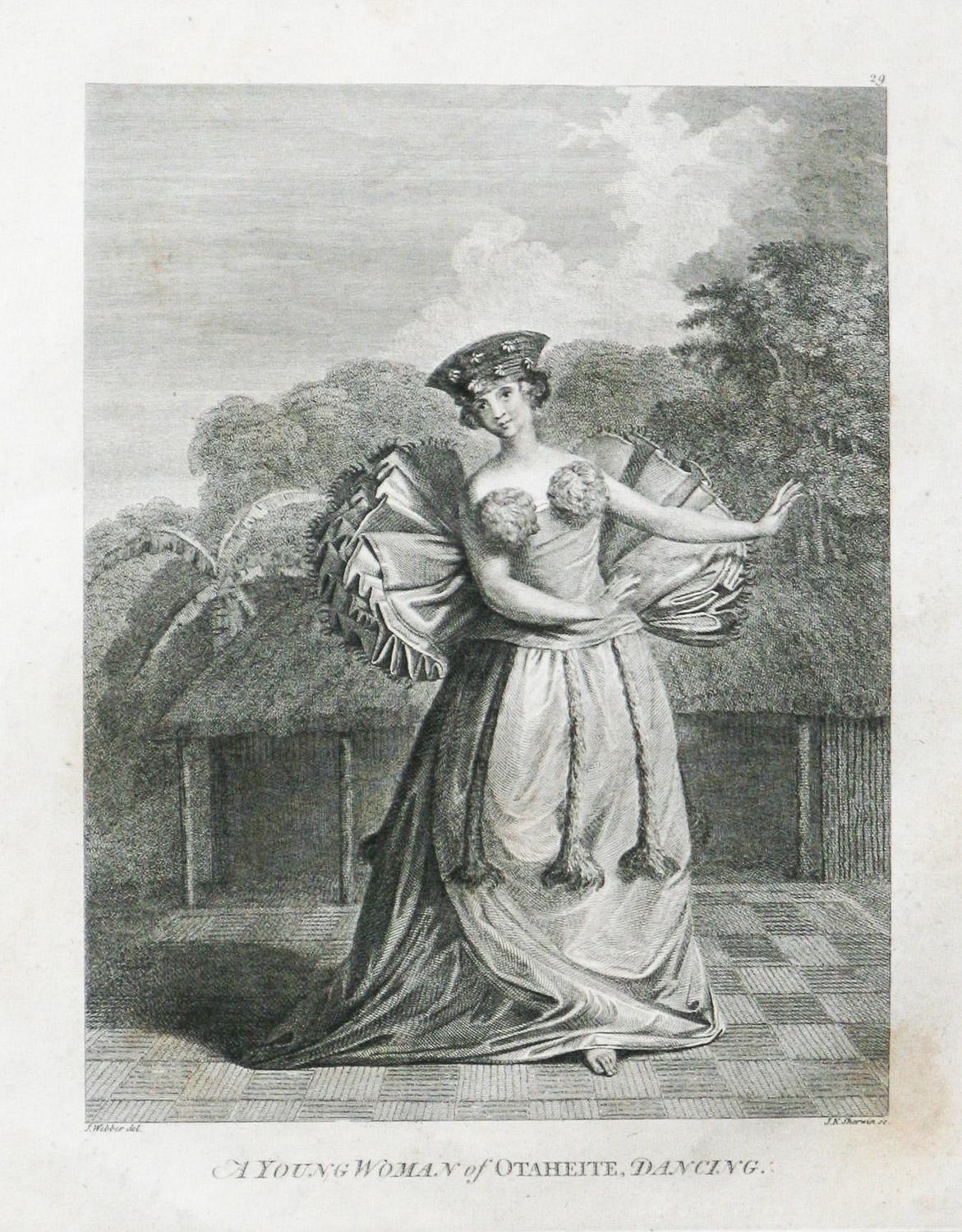Items Similar to Balaclava - The target in sight -
Want more images or videos?
Request additional images or videos from the seller
1 of 9
Heinrich HaberlBalaclava - The target in sight -c. 1900
c. 1900
About the Item
Heinrich Haberl (1869 Passau to 1934 Munich), Sturmhaube, c. 1900. drypoint, 14 x 10 cm (platemark), 28 x 21 cm (sheet size), 39 x 29 cm (passe-partout), titled "Sturmhaube" in lead at lower left and inscribed "Kaltnadelradierung", signed and locally inscribed "Heinrich Haberl Mchn. [Munich]" at lower right, inscribed again in lead on verso and with old collection stamp.
- slightly darkened, fixed and mounted
- The target in sight -
About the artwork
The theatrical "role-portrait" is to be seen against the background of the Rembrandt cult, which reached its climax at the end of the 19th century. The soldier seems to have stepped straight out of Rembrandt's Night Watch (1642) to fix something outside the picture with an alert and ready gaze. The steeply rising brim of the morion frames the gaze and thus perspectivises it as the actual 'pictorial action'. The gaze represents both the vigilant defence and the visionary goal of the battle.
Not only the subject, but also the style of the etching needle reflect Rembrandt's understanding of the times. Strong contrasts of light and dark are created in a virtuoso free stroke, without losing the effect of the reflections on the helmet and in the eyes. This shows a kinship with the early prints of Lovis Corinth, who also saw himself as an artist in the role of the knight. Against this background, Haberl's picture can also be seen as a representation of his artistic self-image.
About the artist
Heinrich Haberl first attended the art school in Nuremberg and from 1892 studied at the Munich Academy. There he was a master student of Johann Leonhard von Raab, Rudolf von Seitz, Franz von Defregger and Peter von Halm. From 1897 he supplied etchings to the Glass Palace in Munich and was represented at the Great Berlin Art Exhibition, the Dresden Art Exhibition and the Leipzig Book Trade Exhibition. Between 1902 and 1904 he worked as an illustrator for the magazine 'Jugend'.
Selected Bibliography
Thieme-Becker, Allgemeines Lexikon der bildenden Künstler, Bd. XV, Leipzig 1922, S 396.
Sauer, Allgemeines Künstler-Lexikon, Bd. 67, Berlin - New York, S. 81.
GERMAN VERSION
Heinrich Haberl (1869 Passau bis 1934 München), Sturmhaube, um 1900. Kaltnadelradierung, 14 x 10 cm (Plattenrand), 28 x 21 cm (Blattgröße), 39 x 29 cm (leinenüberzogenes Passepartout), links unten in Blei mit "Sturmhaube" betitelt und mit "Kaltnadelradierung" bezeichnet, rechts unten mit "Heinrich Haberl Mchn. [München]" handsigniert und ortsbezeichnet, verso nochmals in Blei bezeichnet und mit altem Sammlungsstempel.
- leicht nachgedunkelt und am Passepartout fixiert
- Das Ziel im Visier -
zum Kunstwerk
Das theatralische „Rollenporträt“ ist vor dem Hintergrund der am Ende des 19. Jahrhunderts kulminierenden Rembrandtverehrung zu sehen. Der Soldat scheint geradewegs der Nachtwache (1642) Rembrandts entstiegen zu sein, um mit wachem und bereitem Blick etwas außerhalb des Bildes zu fixieren. Dabei verleiht die steil nach oben zusammenlaufende Krempe des Morion dem Blick eine Rahmung, wodurch der Blick als eigentliche ‚Bildhandlung‘ perspektiviert wird. Der Blick steht gleichermaßen für die wachsame Verteidigung wie für das visionäre Ziel des Kampfes ein.
Nicht allein das Motiv, auch der Duktus der Radiernadel entspringt dem damaligen Rembrandtverständnis. In einer virtuos freien Strichführung werden starke Hell-Dunkel-Kontraste erzeugt, ohne dass dadurch die Wirkungen der Reflexe auf dem Helm und in den Augen verlorengehen würden. Hierin zeigt sich eine Verwandtschaft mit den frühen Grafiken von Lovis Corinth, der sich als Künstler ebenfalls in der Rolle des Ritters sieht. Vor diesem Hintergrund ist auch Haberls Bild als Darstellung seines künstlerischen Selbstverständnisses zu betrachten.
zum Künstler
Heinrich Haberl war zunächst an der Nürnberger Kunstschule und studierte ab 1892 an der Münchner Akademie. Dort war er Meisterschüler bei Johann Leonhard von Raab, Rudolf von Seitz, Franz von Defregger und Peter von Halm. Fortan in München ansässig, beschickte er ab 1897 den Münchner Glaspalast mit Radierungen und war auf der Großen Berliner Kunstausstellung, der Dresdner Kunstausstellung und der Leipziger Buchgewerbeausstellung vertreten. Zwischen 1902 und 1904 war er Illustrator der Zeitschrift ‚Jugend‘.
Auswahlbibliographie
Thieme-Becker, Allgemeines Lexikon der bildenden Künstler, Bd. XV, Leipzig 1922, S 396.
Sauer, Allgemeines Künstler-Lexikon, Bd. 67, Berlin – New York, S. 81.
- Creator:Heinrich Haberl (1869 - 1934, German)
- Creation Year:c. 1900
- Dimensions:Height: 15.36 in (39 cm)Width: 11.42 in (29 cm)Depth: 0.4 in (1 cm)
- Medium:
- Movement & Style:
- Period:
- Condition:
- Gallery Location:Berlin, DE
- Reference Number:1stDibs: LU2438212338412

About the Seller
5.0
Vetted Seller
These experienced sellers undergo a comprehensive evaluation by our team of in-house experts.
Established in 2014
1stDibs seller since 2023
7 sales on 1stDibs
Typical response time: 5 hours
- ShippingRetrieving quote...Ships From: Berlin, Germany
- Return PolicyA return for this item may be initiated within 14 days of delivery.
More From This SellerView All
- General Wilhelm von Blume - Visionary retrospective -Located in Berlin, DEBernhard Pankok (1872 Münster - 1943 Baierbrunn), General Wilhelm von Blume, 1915, aquatint etching, 34 x 29.5 cm (sheet size), 26 x 22 cm (plate size), signed in the plate at upper left, in pencil at lower right and dated in pencil at lower left. - At lower left old collection stamp, at the right broad margin with a small spot, otherwise very good condition. About the artwork The 1915 aquatint etching of General Wilhelm von Blume is based on a 1912 oil painting in the LWL-Museum für Kunst und Kultur in Münster. A second oil portrait of the general by Pankok is in the Staatsgalerie Stuttgart. When Pankok painted the first oil portrait in 1912, the general had already been retired for 16 years. It is therefore a retrospective portrait. Accordingly, the orientation of his head is such that he is looking back in both the oil painting and the etching. Without fixing on anything in particular, he looks thoughtfully inwards and reflects on his life. Uniformed and highly endowed, it is his military activities in particular that he is reviewing attentively and, as his gaze reveals, quite critically. Pankok has literally written the sum of his experiences on Wilhelm von Blume's face: The physiognomy is a veritable landscape of folds, furrows, ridges and gullies, all the more striking against the flat background. It is clear that each of the medals was also won through suffering. However, by breaking the boundaries of the picture, his bust appears as an unshakable massif, which gives the general a stoic quality. The fact that the design of the portrait was important to Pankok can be seen from the different versions, the present sheet being the third and probably final revision, which Pankok dates precisely to 18 February 1915. Compared with the previous state, the light background now has a dark area against which the sitter's face stands out, the dark background in turn combining with the uniform to create a new tension in the picture. Pankok's taking up of the portrait of the high-ranking military veteran and its graphic reproduction can also be seen in relation to the First World War, which had broken out in the meantime. In the face of modern weapons of mass destruction, Wilhelm von Blume's warfare and military writings were relics of a bygone, more value-oriented era. About the artist After studying at the Düsseldorf Art Academy from 1889 to 1891 under Heinrich Lauenstein, Adolf Schill, Hugo Crola, and Peter Janssen the Elder, Bernhard Pankok went to Munich in 1892, where he worked primarily as a graphic artist for the two major Jugendstil magazines "Pan" and "Jugend," which established his artistic success. Through this work he met Emil Orlik, with whom he had a lifelong friendship. In 1897, he exhibited his first furniture, and in 1898, together with Richard Riemerschmid, Bruno Paul and Hermann Obrist...Category
1910s Realist Portrait Prints
MaterialsEtching
- Half-length portrait of a man with beard - A Rembrandt of the 18th century -Located in Berlin, DEJohann Friedrich Bause (1738 Halle a. d. Saale - 1814 Weimar). Half-length portrait of a man with beard and cap after a drawing by Christian Wilhelm Ernst Dietrich. Etching and coppe...Category
1780s Baroque Figurative Prints
MaterialsEtching
- Agony - The architecture of decay -Located in Berlin, DEJörg Olberg (*1956 Dresden), Agony, 1987. etching, E.A. (edition of 30), 24 x 17 cm (image), 46 x 37 cm (sheet), each signed in pencil lower right "Olberg" and dated "IX [19]87", inscribed lower left "E.A. [Epreuve d'Artiste]". - minimal crease and dust stains in the broad margin - The architecture of decay - About the artwork Jörg Olberg draws here the sum of his artistic study of the Berlin ruins, which were still present in the cityscape well into the 80s. With his work "Agony" he creates an allegory of decay. Positioned in the landscape of ruins, a ruined house grows before the viewer, rising like the Tower of Babel into the sky, its roof and gable brightly illuminated by the sun. But already the roof shows mostly only the rafters, and as the gaze is drawn further down, the building visibly disintegrates, the beams protruding in all directions looking like splintered bones. Slowly but inexorably - in agony - the house will collapse in on itself and become nothing more than the burial mound of itself. At the same time, the small-scale stone composition and the plaster form a pattern-like ornamentation of decay. The tension in the picture is fed by the counter-movement of growth and collapse, which is heightened by the dramatic formation of clouds. The swirls of clouds are reminiscent of a world landscape...Category
1980s Realist Figurative Prints
MaterialsEtching, Paper
- The Talisman (so called Dukatenscheisser) - The philosopher's stone -By Carl PlückebaumLocated in Berlin, DECarl Maria Plückebaum (1880 Düsseldorf - 1952 ibid.), Der Talismann (sog. Dukatenscheisser), partly colored etching, 11.5 x 8.5 cm (plate size), 26.5 x 20 cm (sheet size), signed by hand below the image on the right "C. Plückebaum" and inscribed by hand at lower left "Der Talismann". - left and right side of the sheet with browned stripes, otherwise good copy - The philosopher's stone - About the artist Here, Carl Plückebaum gives free rein to his anti-academic impulses and turns the subtle humor of his pictures into crudeness. Following Adrian Ostade's peasants as they go about their needy business, we see a cowardly fellow in a squatting position. His excrement, however, is not the organic remains of digestion, but - like the golden donkey in the Grimm fairy tale - ducats. However, they appear more brown than golden, which is emphasized by the discreet hand-coloring of the picture. The unattractive accumulation is countered by the blossoms decorating the crouching man's hat. Totally absorbed in his action, his activity is evident in the strained expression on his face, giving Plückebaum a whole new verisimilitude to the concept of naturalism. The title "The Talisman" then turns naturalism back to the miraculous, formulating in a humorous way that these legacies are also a "miracle of nature". About the artist Coming from a poor background, Carl Plückebaum, who had a walking disability and was of short stature, initially worked as a church restorer. He also took private drawing lessons. In 1901 he won the first prize of the Düsseldorf Museum of Decorative Arts, which enabled him to finance his studies at the Düsseldorf Academy. There he was a pupil of Eduard von Gebhardt and Peter Janssen the Elder, but began to doubt the academic teaching. In 1906 he took part in a group exhibition at the Städtische Kunsthalle Düsseldorf, which violated the academy's statutes and led to his dismissal. However, the extraordinary success with the public confirmed him as an artist and provided him with the financial means for a study trip to Italy. Enchanted by Florence, he retired to the Franciscan monastery of Fisole, where he worked as a fresco painter. Back in Düsseldorf, he turned increasingly to children's and animal drawings, and in 1907 he was a founding member of the Niederrhein Secessionist Artists' Group. In 1910 he travelled to Italy again, accompanied by his painter friends Walter Ophey and Carl Schmitz-Pleis, visiting Rome and Naples in particular. He then stayed in Munich to study the Old Masters at the Pinakothek. It was in the artistic circles of Schwabing that he met his future wife, the painter Meta Weber. In Düsseldorf, Carl and Meta Plückebaum...Category
Early 20th Century Realist Figurative Prints
MaterialsEtching
- View of a coastal town / - The Pilgrim's View -Located in Berlin, DEAlbert Ernst (1909 Fronhofen - 1996 Hamburg), View of a Coastal Town, etching, 30 x 37 cm (picture), 45 x 50.5 cm (frame), signed in pencil lower right "Albert Ernst", framed under g...Category
Mid-20th Century Realist Landscape Prints
MaterialsEtching
- Rudolf v. Rittner as Florian Geyer - Last man standing -By Lovis CorinthLocated in Berlin, DELovis Corinth (1858 Tapiau - 1925 Zandvoort), Rudolf von Rittner as Florian Geyer, 1924 (Müller 854), drypoint signed in pencil. 20.4 × 14.2 (plate size), 37.7 × 30.6 cm (sheet size). Published by Karl Nierendorf, Berlin. Framed in a passepartout. - Strong, precise impression. Frame a little bit rubbed and with two small damages. About the artwork The knight is a leitmotif in Lovis Corinth's work, culminating in his Self-Portrait in Armour of 1914. Of all the paintings on this theme, Corinth most often depicted Florian Geyer. Descended from a Franconian noble family, he fought for the freedom of the peasants during the peasant wars of the Reformation, first diplomatically and then militarily, leading the legendary Schwarzen Haufen (Black Troops). The name derives from the black uniforms with which Geyer dressed the peasants willing to fight. During the Napoleonic occupation, the freedom fighter Florian Geyer was sung about by the Romantics, and the free corps Die Schwarze Schaar, founded in 1813 by Major von Lützow, succeeded the Schwarzer Haufen. It was against this historical background that Gerhard Hauptmann wrote the revolutionary drama Florian Geyer, which premiered at the Deutsches Theater in Berlin in 1896. While the actor Rudolf Rittner, who would later appear in Fritz Lang's films, initially played the role of Schäferhans, he took over the leading role in the new production at Berlin's Lessing Theatre in 1904, again directed by Emil Lessing, which established his fame as an actor. Hauptmann himself praised the acting. He wrote to Hugo von Hofmannsthal: "It went quite well with Florian Geyer. In any case, I had the great pleasure of seeing the play again in an admirable performance". And Lovis Corinth was so taken with Rittner's performance that he painted an oil portrait of him in the role of Florian Geyer in 1906. After two further graphic versions in 1915 and 1920/21, Corinth returned to the painting a year before his death and almost twenty years after the oil painting to create this graphic version in 1924. Even the inscription in the picture was taken over. This proves all the more the importance of the knight and freedom fighter for Corinth's self-image. The oil painting, in particular, proclaims the single-minded determination to fight to the last for the values defended, manifested in the oil painting by the tattered flag held out to the enemy. There is a parallel with Rainer Maria Rilke's 1899 story The Cornet, in which the protagonist goes down with the flag that he first saved at the risk of his life. Consequently, the portrait is also a self-portrait, and the knight's armour is not an academic costume or an ironic refraction, but an expression of Corinth's self-image, which also includes his self-representation as an artist. The Secession poster...Category
1920s Expressionist Figurative Prints
MaterialsEtching
You May Also Like
- Jim Dine Rimbaud, the Coffee Exporter poet portrait drawing in earth tone sepiaBy Jim DineLocated in New York, NYJim Dine has expertly sketched the accomplished French poet and coffee trader Arthur Rimbaud. A vignette of dark brown surrounds his thin, fine features, which are defined with a flu...Category
1970s Realist Portrait Prints
MaterialsEtching
- Jeune Femme Cousant; Madame Helleu (Young Woman Sewing, artist's wife)By Paul César HelleuLocated in Middletown, NYParis: Gazette des Beaux Arts, 1892. Etching and dry point on cream laid paper. 7 9/16 x 5 7/8 inches (191 x 148 mm), full margins. Signed in pencil, lower right margin. A dark, ink...Category
Late 19th Century Realist Portrait Prints
MaterialsDrypoint, Etching
- Judaica Woodcut Print Jewish Rabbi Hachnasas Torah Procession WoodblockLocated in Surfside, FLThis does not appear to be signed. not examined out of frame. In the manner of Frans Masereel here is an old woodblock print of a Jewish religious scene of the induction of a new torah in a procession with a chuppah, wedding canopy. In the tradition of the Jewish European artists of the 19th and early 20th centuries, such as Moritz Oppenheim, Max Liebermann, Lesser Ury, Jakob Steinhardt, Jehudo Epstein, Artur Kolnik, Stanislaus Bender...Category
Early 20th Century Realist Figurative Prints
MaterialsWoodcut
- A Man of Mangea 1784 final voyage of Captain Cook by John WebberBy John WebberLocated in Paonia, COA Man of Mangea is from the 1784 First Edition Atlas Accompanying Capt. James Cook and King; Third and Final Voyage of Captain James Cook. John Webber (1752-1793) was the official a...Category
1780s Realist Portrait Prints
MaterialsEngraving
- A Young Woman of Otaheite, Dancing (Tahiti) 1784 Captain Cooks Voyage by WebberBy John WebberLocated in Paonia, COA Young Woman of Taheite Dancing (Tahiti) is from the 1784 First Edition Atlas Accompanying Capt. James Cook and King; Third and Final Voyage of Captain James Cook.John Webber (1752-...Category
1780s Realist Figurative Prints
MaterialsEngraving
- A Man of Kamtschatka (Russia) 1784 Captain Cooks Final voyage by John WebberBy John WebberLocated in Paonia, COA Man of Kamtschatka (Russia) is from the 1784 First Edition Atlas Accompanying Capt. James Cook and King; Third and Final Voyage of Captain James Cook. John Webber (1752-1793) was t...Category
1780s Realist Figurative Prints
MaterialsEngraving
